Brisbane, Where I Live
I was born in Warwick, about 130 km south west of Brisbane in 1944 during
World War II. The family then moved to Melbourne where in 1946 my sister,
Denise was born. A year later we moved to Brisbane and it was here I have
since lived. This post is about Brisbane's early history although the photos I
have taken and used in this post are of today's time frame. There are not a
lot of accessable photos taken of ye ole' days. Those few I will use I have
either scanned from old photos or obtained from the net.
As it turns out this post like others I have blogged seem to become "bigger
than Ben Hur" so I will have to do this in a two maybe three parter.
If you are interested in reading history of various places then you may find
this quite interesting. It took quite some time to research what I have used
and I have put this into the post in no particular sequence other than the
fact I have started with the early history of Brisbane. I must admit I also
came across some facts of Brisbane I had not know before so one can learn
the hows, wheres and whys of the history of your own town/city/country
by (in days gone by) going to your library and now searching on the net.
Its climate is sub-tropical with an average annual rainfall of 1090 mm (most
of which falls between December and March), an average of over seven hours
of sunshine each day, a humidity level which hovers around 50 per cent for
all the year, and a temperature range from 10°C in winter to 30°C in summer.
In July 1825, after an unsuccessful attempt to settle at Redcliffe, a harsh
penal colony was established on the present site of
then Governor of New South Wales, Sir Thomas Brisbane. In March 1826,
Captain Patrick Logan was appointed the new commandant and during the
next four years gained a reputation as the most cruel in the colony.
An unflattering convict ballad, "
his murder in 1830.
The selection of
Redcliffe, north of the city, was the original preference when Surveyor
General John Oxley, aboard the cutter 'Mermaid', first surveyed the region
late in 1823. The boat was anchored off
group of Aborigines and "one who appeared larger than the rest" on the shore.
This was an ex-convict called Thomas Pamphlett, one of four men who had
left
Pamphlett and a fellow survivor of the journey, Finnegan, had been living with
the Aborigines for several months when Oxley spotted Pamphlett on a beach
in
seen in the area. Intrigued, Oxley set off in a whaleboat with a small crew and
Finnegan as their guide.
Oxley found the river the next day and named it in honour of the then
Governor of New South Wales, Sir Thomas Brisbane. It was the red cliffs
north of the river that impressed him as the most suitable site for the new
penal settlement.
Redcliffe site was abandoned mainly because
water supply. It was also surrounded by a bend in the river, which meant
that escape was more difficult.
With a government decree forbidding unauthorised people coming within
fifty miles, the walled gaol operated for the next seventeen years, taking only
the toughest prisoners from
makers in
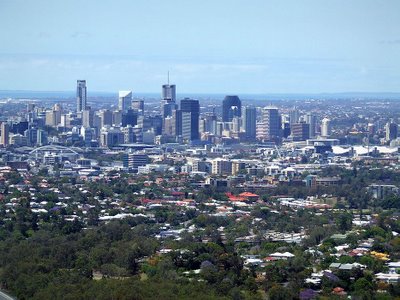 View of Brisbane taken from the look-out at Mt. Coot-tha.
View of Brisbane taken from the look-out at Mt. Coot-tha.
Corps (the "Anzacs")
Anzac Square contains the Shrine of Remembrance and the 'Eternal Flame'
as well as the World War II Shrine of Memories. The Shrine was dedicated
on Tuesday, 11 November 1930.
The external wall of the Shrine of Memories is dedicated to Queenslanders
who fought in World War I. There are also war-related statues, for various
wars, including memorial statues for the Queensland soldiers who fought
during the Second Boer War (1899-1902), as well as World War II, the
Vietnam War and campaigns in Korea, Borneo and New Guinea.
The 18 columns represent the year of peace after World War I - 1918.
Also symbolizing that year are the number of stairs leading up to the
Shrine - 19 stairs in the first row and 18 in the second row.
The bottle trees commemorate the Queensland Light Horse Regiments
which served in South Africa's Boer War (1899 to 1902). Before Federation
Queensland sent six contingents of soldiers to South Africa.
The palm trees are Middle East date palms and they represent Australia's
success in the Middle East during both World Wars. The palms are also a
biblical symbol of victory.
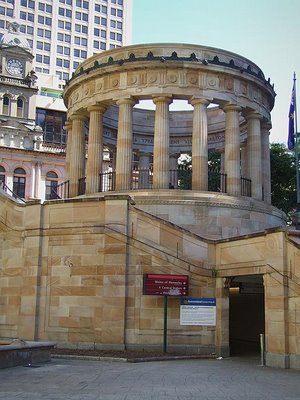 Side view of The Shrine of Remembrance
Side view of The Shrine of Remembrance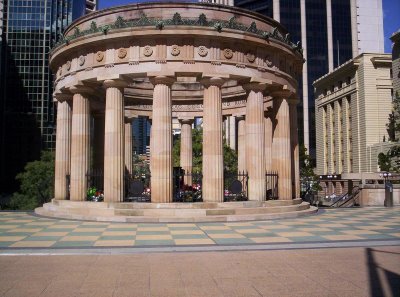 Front View of The Shrine of Remembrance
Front View of The Shrine of Remembrance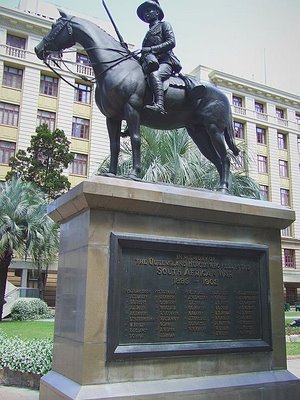 At the Elizabeth Street entrance to Anzac Square the visitor is met by the Boer War Mounted Trooper on a plinth that bears an Honour Roll of Queenslanders who fall in that war.
At the Elizabeth Street entrance to Anzac Square the visitor is met by the Boer War Mounted Trooper on a plinth that bears an Honour Roll of Queenslanders who fall in that war.Viewed from King George Square this gracious church was built in 1889.
Inside, the stained glass windows, mostly memorial, and the timberwork
of the choir stalls and pulpit are exceptional. The organ has 2,250 pipes
altogether, some brightly painted. It was made in Manchester, England,
and its character has been preserved through rebuilds over the years.
Initial construction cost: £12,500.
The church was renovated in 1974/1975 at a cost of $128,476 and again
in 1989 at a cost of approximately $150,000.
Roof: Spanish Slate
Walls: Brick, not buttressed
The Ceilings are made of Pine
The Communion and Gallery Rails are crafted in Cedar
Pillars: Solid steel, support gallery and roof.
Windows: Downstairs, mainly memorial
Upstairs, some memorial, the remainder original lead light.
Nine windows on the Ann Street side downstairs are a memorial to
RAAF crew lost in World War II.
Organ: Benson imported from Manchester England in 1889 for £1,000.
Three manual organs. Some rebuilding in 1928 – chimes fitted.
Major rebuild in 1951, cost $5,200. Complete rebuilding of organ in
February 1985 at a cost of $77,000.
Capacity: The Church seats approximately 1,000 people.
350 downstairs and 650 upstairs.
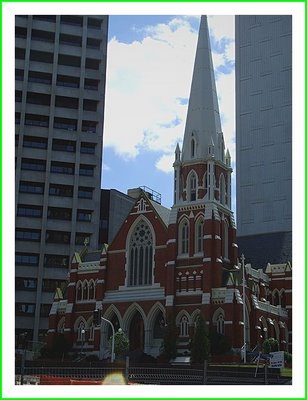 This was the best photo I could take of the church due to the fact of direct sunlight and construction work being done nearby.
This was the best photo I could take of the church due to the fact of direct sunlight and construction work being done nearby.It was in this church I was married in 1979.
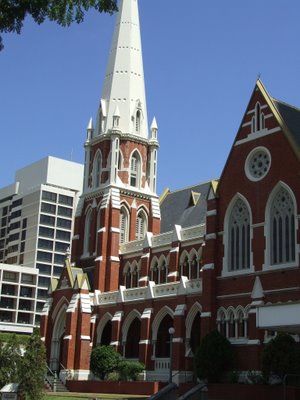 Side view of the Albert Street Uniting Church (Methodist & Presbyterian)
Side view of the Albert Street Uniting Church (Methodist & Presbyterian)The Moreton Bay district of what is now the State of Queensland
was officially opened to free settlement in 1842 and growth of the
Port of Brisbane quickly followed. The Colony of New South Wales
declared Brisbane a ‘Port of Entry and Clearance’ in 1846. The
original Custom House was built in 1849 at a bend in the Brisbane
River known as Petrie’s Bight. It was demolished in 1886 at the
commencement of construction of the new Custom House. With its
solid Corinthian columns and its greenish copper dome the Customs
House stands beside the Brisbane River like a great Victorian matriach.
Its position and prominence ensure that it is one of Brisbane's most
impressive landmarks. It was built by John Petrie between 1886-89
and features twin pediments.
This building was used for Customs operations in Brisbane for the next
100 years. Originally referred to as ‘Custom House’, it has been referred
to as ‘Customs House’ since Federation in 1901 and was used for the
collection of Customs duty.
The building, which dates back to colonial times, is now leased by the
University of Queensland. There is a restaurant within the building,
and regular concerts and art exhibitions are also held at the building.
The grandeur of its architecture, the spectacular views of the river
from its balconies and reception rooms, and the sheer magnificence
of its interior decor makes Customs House a classically elegant and
romantic venue for many weddings that can be held in this magnificent
building.
My first job was working for a shipping company and I can remember
going to the Customs House on a number of occaisions to lodge documents
for customs clearances.
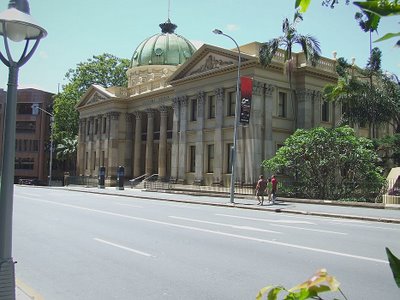 Side View of The Customs House
Side View of The Customs House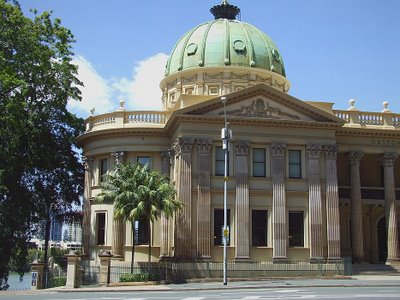 Partial View of The Customs House showing the magnificent copper dome.
Partial View of The Customs House showing the magnificent copper dome.
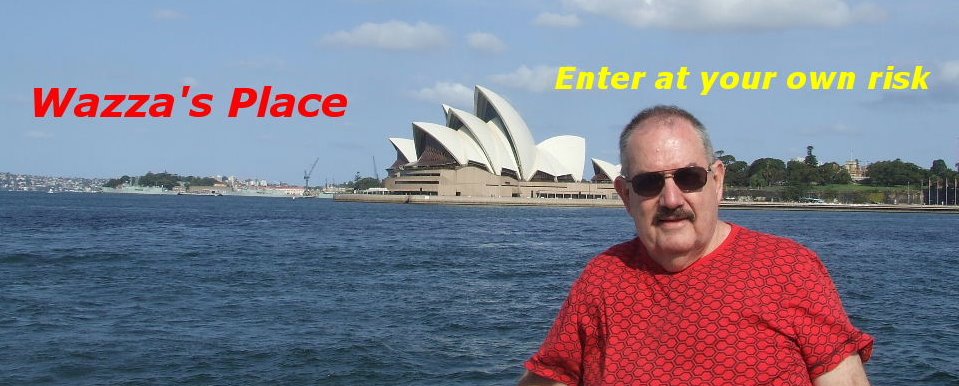
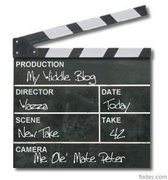
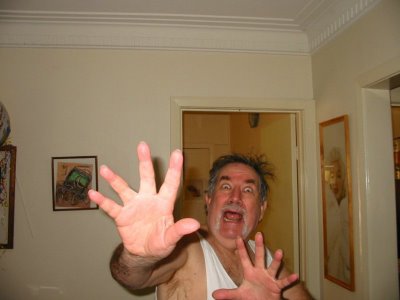


9 comments:
How many parts are we lookin' at here Wazza?
Enjoyed this post, looking forward to next instalment! Cheers Margaret
Brisbane is a beautiful city, Wazza, thank for sharing.
Have a great weekend.
Take care, Meow
Arrrrggggh! I wrote a very long spiel...and it didn't come up so now I'm going to have to repeat myself! Grrrrrr! Well, in a nutshell, I posted that I lived in Brisbane for fourteen years and at one point had a flat right on the river bank at New Farm, just along from the park. In the gardens of the house, which had been converted into having a one-bedroom flat...the balance of the house was where the landlady lived. The front garden had rows and rows of roses growing. When they they bloomed they were absolutely magnificent. The house no longer exists...which means of course, neither do those wonderful roses!
Great pictures...particularly love the ones you took of the roses in New Farm Park. Great blog. :) I hope this post goes through...or I'll be grumbling all night! ;)
Whooohoooo! It worked! :) No more grumbling! ;)
Wazza ~ Thanks for your post on my lz-blogger.blogspot.com ~ I really enjoyed reading about Brisbane. My wife and I were there last year and just loved the place. I have a shot that looks almost like the one you posted from Mt. Coot-tha. I loved the Australia's Zoo. Also if you didn't know it... the sunrise picture on the top of my blog was taken on the beach at Surfers Paradise right across the street from the Marriott where we stayed. Only spent a couple (3 actually) in Brisbane at the Hilton Brisbane. Still trying to find a place here in the states that has "XXXX Gold" beer, but so far, it looks like you are keeping it ALL in OZ! ~ jb///
Grab yourself some Fosters, Iz...or Crown Lager...much better than XXXX, in my humble opinion...but then I've never lixed Fourex...being a Carlton beer drinker when I have a beer. I prefer the lagers. :)
I have been over reading june's post,
just have to say it Wazza, YIKES!! I remember that blonde hair.
Cheers Margaret
Very informative post about Brisbane and you & I share one thing...we were both born in the same year. Very lovely pictures.
Post a Comment